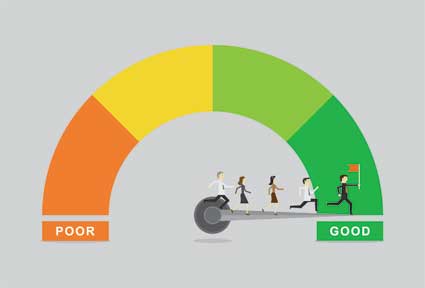The larger and more complex something is, the more there is to look at. Aspects of business such as organizational behavior are made of multiple interconnected and multifaceted parts. Discussing one aspect involves bringing up another and another and another, until you are traipsing along an intricate web that is far larger than you initially thought it to be. It can seem to be endless once you really get started and can overwhelming if you're not adequately prepared for it. This is often the case for many other things and it is up to you to decide how far down the rabbit hole you want to go.
The easiest place to start with organizational behavior, once you've established some of the basics, is to look at its history and the ethical connotations associated with it. It is these two aspects that are tend to be revisited when talking about other aspects, as they tend to provide an explanation as to how that part of organizational behavior came about the way it did. History and ethics can also explain why a certain part of organizational behavior plays the role that it currently does-it may even assist in figuring out how that role will change over time and in certain environments. Most of the organizational behavior trends that are common throughout the business world will, likewise, have their roots in some part of the concept's history or ethics.
This article will take a look at the known history of organizational behavior, both in and outside of business and the professional world. In looking at the historical aspects, the different organizational behavior trends popular with businesses will be explored. The role of ethics, and the ethical responsibilities members of a business have, in organizational behavior will also be a topic of discussion.
Organizational behavior is a concept that is well entrenched into the professional and business worlds. Its presence occasionally goes unnoticed at times, but that does not diminish its role or its history. Neither does the fact that its history as a researched and documented topic of study is a rather recent occurrence.
The American Psychological Association, or APA-the primary scientific organization focusing on the study of psychology in the United States-did not begin to recognize organizational behavior as a serious area of study until the latter half of the twentieth century. For the most part, the APA treats organizational behavior as an aspect of the study of industrial and organizational psychology rather than a standalone field.1 In that regard, the focus is on the role it plays solely in the workplace. This separates it from organizational behavior that appears in conjunction with areas such as academic or home life. However organizational behavior, on its own and as a whole, has been studied across multiple environments before. In fact, the concept had been studied decades before the APA formally recognized it.
- The Hawthorne Studies-Through the 1920s into the 1930s, a series of human behavior studies were conducted at the manufacturing facility known as the Hawthorne Works in Cicero, Illinois. The plant was owned by Western Electric (WE), one of the early precursors to the modern day company AT&T or Lucent Technologies, and was one of the largest manufacturing sites for WE at the time. There were around 40,000 workers on staff during the studies, which was a rather decently sized data source for the research. It also had been in operation for around 10-20 years at that point so a production routine and environment was already well established.
Elton Mayo and Fritz Roethlisberger, the Harvard-based researchers who began the first set of studies, looked to find if there was some kind of correlation between the productivity of workers and their work conditions. The initial experiments focused on the potential effect of the lighting in a workplace on productivity from 1924 to 1927, but that failed to show any correlation. It was then that they shifted their focus towards how human psychology and behavior can be used to improve existing management practices based on the existing relation between the two. Their idea was building off of a developing school of thought that employees have non-financially based needs that have to be addressed in the workplace. Money isn't the ultimate source of motivation and it can't be the only thing that employers and business owners depend on.
Interested in learning more? Why not take an online Organizational Behavior in Business course?During the study, researchers began making adjustments to the working conditions and monitor any changes in production and the behavior of the employees the changes brought about. Some changes were purely environmental-adjusting temperature, air filtration, and light placement. Others focused on human needs like breaks, set work hours, areas of work, and interactions amongst co-workers and their supervisors. When changes were made to ease workplace stressors-like two ten-minute breaks for rest-there was a noticeable improvement in production where the output rate increased. Workers who were put into independent groups also seemed to have higher production rates and more cohesion than the main assembly line. Rates of fatigue amongst workers also seemed to decrease and attendance rates improved. Strangely enough, productivity remained about the same after the changes were removed and the original conditions returned. The reasoning was that the workers were made to feel less like a cog in a machine and more like actual human beings.5 The presence and attitudes of supervisors also seemed to back this up, as areas or groups helmed by a more disciplinarian or berating supervisor were less productive than when there was a friendly supervisor or no supervisor at all. Roethlisberger dubbed this as the Hawthorne Effect in later studies.6
While the Hawthorne Studies are considered to be the first of their kind and the most well-known organizational behavior study, it is not the only one. Decades earlier Frederic Winslow Taylor attempted to determine the role of human behavior in the workplace, albeit from a more mechanical approach.7 At the time, workers were simply the labor force and anything that went wrong during production was blamed on them, even if it was in no way their fault. As workers were thought to be inherently lazy and heavily error-prone, they were treated as such to avoid making more errors. Needless to say, it wasn't as effective as businesses and managerial staff desired it to be. Taylor's theories involved removing human error by assigning a worker to every part of production, with uniformity throughout each stage. This was more of a systematic approach that the Hawthorne Studies improved upon with the inclusion of a focus on human relations, but at the time it was a rather ingenious theory and generated significant improvement in the industrial sectors. For many years-before and after the Hawthorne Studies-Taylorism was the go-to practice for the workplace.
Taylor's studies may have preceded the Hawthorne Studies, the Theory X and Theory Y of Douglas McGregor proceeded it. McGregor followed the human relations school of thought the Hawthorne studies popularized and suggested that a lot of the organizational behavior flaws in the workplace were based on the behavior of the management staff rather than the regular workers. With research, he proposed that managers tend to make decisions based on their bias, assumptions, and generalizations regarding their workers. These were deemed Theory X, and seemed to follow a more authoritarian approach that frequently involved micromanaging and exerting control.8 Theory Y was more participative, with managers operating with the idea that workers have pride in their work and hold themselves accountable. Modern concepts of organizational behavior tend to follow Theory Y-which is what McGregor encouraged mangers to do-to bolster creativity and innovation, garner workplace feedback, produce motivation, and generate cohesion amongst staff. At the time of McGregor was presenting his Theories in the 1960s, the APA was just beginning to recognize organizational behavior as a formal field of study.
In the years since these studies and the APA's inclusion of organizational behavior, the field has grown significantly. The increases in diversity and cultural shifts-plus a booming population-have, in part, been responsible as the backgrounds of the workforce become more varied. Changes in technology and the world of business, too, have been a contributing factor. The cumulative history of organizational behavior has largely shaped most of the attitudes and practices found in the Human Resources departments in business across the country. Modern day modifications to organizational behavior have put an increased focus on positive group dynamics-think team and group work-and leadership. Workers who excel in either aspect often tend to excel in other aspects of organizational behavior present in their workplace. As a result, leadership abilities and teamwork are held in rather high regard in many professions.
What Ethical Responsibilities Are There?
Ethics often tend to determine what kind of behavior and attitudes are considered acceptable in society. Many social rules are ethically based and businesses operate on their own code of ethics, which shares characteristics with the social code. Businesses that, essentially, act according to these rules are more likely to do better than those that do not due to widespread application.9 Think about businesses and companies that fail to follow regulations and ethical practices. What usually happens when it's publically revealed that they have been going against those rules and are committing ethics violations? Not only is there punishment in some form from the authorities, but there's usually backlash from their customers and employees. Other businesses working with them tend to distance themselves, sales and stocks drop, and no one seems to want to touch them with so much as a ten-foot pole. Those violations may have been revealed by employees who have been mistreated as a result of the business' unethical practices and took action, which can affect the public response even more.
Following ethical standards typically is key for successful organizational behavior in a business. However, there is some question as to who is responsibility is it to ensure that ethics are followed.
- The Employers and Owners-The enforcement and establishment of ethics in the workplace typically falls almost in full on those in charge of the business. Part of this is because of legal requirements to ensure things like health and safety, transparency, and providing fair work conditions for the business.10 Employees and customers also tend come to a business with the expectation that those things will already be in place before the business even opens.
- The Employees-In regards to ethics, employees are expected to act according to the rules that have been established and adhere to the appropriate standards and policies. After all, the system of ethics and organizational behavior isn't going to work or be very effective if no one is participating in it. Not only are they supposed to practice ethical behavior, but employees are also supposed to make sure their peers in the business do so as well.11 This applies to co-workers, supervisors, and, when applicable, the customers as well.
- The Customers-While customers won't necessarily know the fine details of the ethics laid out in company policies, they at least will know society's ethical standards. Customers should practice basic ethical behavior when interacting with businesses, as well as any policies set forth by the business specifically for their clientele. There is also some responsibility for customers to help keep the businesses they interact with ethically accountable. Most violations can be reported to management, like unethical or hostile behavior from an employee, but larger transgressions like actively harming others or other inhumane practices should be reported to the proper authorities. The procedure for this will definitely depend on the situation and the location of the business.
Trends in Organizational Behavior in Business
As mentioned previously in this article, a focus on teamwork and leadership are current trends in organizational behavior in business. While they are being viewed as important across industries, they are not the only ones:
- Adaption to Change-Businesses that are able and willing to adapt to the changes being thrown at them are much more likely to succeed than others who do not. Those adaptions need to apply to all aspects of the business, including its organizational behavior practices. This can be seen more so as a means of survival, but it has been treated as a trend as of late.
- Globalization-Businesses are no longer isolated to their brick-and-mortar locations and their consumer base isn't as local as it was a hundred or even fifty years ago. The global nature of business has largely changed the game for most companies, and their practices tend to reflect that.12 Employees and customers are bringing in much more varied views and attitudes, so it extends to nearly all parts of a business as well.
- Employee Engagement-Relations between employers and their employees are changing, moving more from McGregor's Theory X toward Theory Y. How employers interact with their employees and keep them interested or motivated is noticeably friendlier and "fun" in some cases. This approach has actually prompted better participation and communication within business practicing it.



























